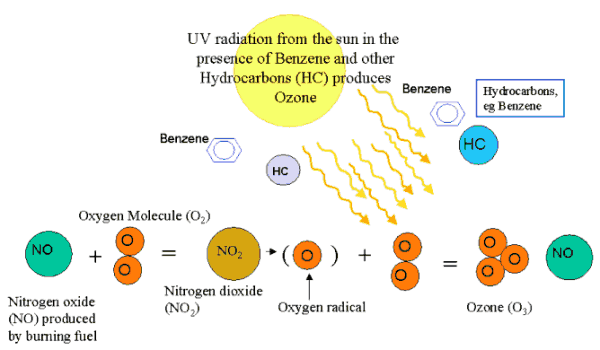| Environmental Concerns |
|
In Unit 3 we introduced the topic of pollution and discussed some of the major air pollutants. Burning fossil fuels such as petrol and diesel produces a number of unwanted bi-products, and transport is the largest source of carbon monoxide, (which is directly related to the production of carbon dioxide), volatile organic compounds and nitrogen oxides. Nitrogen oxides known as NOx and Volatile Organic Compounds (VOC's) can react together in the presence of sunlight to produce "photochemical" pollution. The most well known and abundant photochemical pollutant produced is Ozone. This might seem odd since most discussions about ozone relate to the "hole" in the ozone layer and concerns about the reduction in ozone. However, whilst ozone is crucial to protecting the earth from solar radiation at very high altitudes (in the stratosphere), it is unwanted in the troposphere (closer to the ground). |

|
| Figure 1: There is quite a complicated relationship between NOx's and Ozone, however a "simplified" picture is shown above. |
|
NO is converted to nitrogen dioxide NO2, which can absorb the energy that sunlight produces causing it to break apart and produce oxygen atoms that combine with the O2 in the air to produce ozone (O3). Ozone is a powerful oxidising agent, and a toxic gas. Elevated levels of tropospheric ozone are thought to cause several billion dollars per year damage to crops, structures, forests, and human health. In addition nitrogen contributes to "acid rain", adsorbed into water droplets it can produce nitric acid which makes up approximately one third of the acid in acid rain. Volatile Organic Compounds (VOC's) are released in vehicle exhaust gases either as unburned fuels or as combustion products, and are also emitted by the evaporation of motor fuels. Benzene and 1,3-butadiene are of particular concern as they are known carcinogens. Up to 20% of a VOC emissions from a vehicle actually occurs during re-fuelling, and as evaporation from the carburettor and the petrol tank. |

|
|
Carbon Monoxide results from the incomplete burning of fuels and interferes with the oxygen carrying capacity of the blood. This is the gas that has had much press recently in the UK with faulty gas fires causing the deaths of a number of people. Other pollutants In addition to the major pollutants identified above, other compounds are emitted in very small quantities, (again as a result of the incomplete fuel burning), and some are highly toxic or carcinogenic. Compounds in this category include:
Finally Lead, (as tetraethyl lead), and particulates are also produced through the burning of petrol. Lead is a poison that builds up and is damaging to the Central Nervous System, it has been linked to damaging the mental development of children. However, with the increasing use of unleaded petrol, emissions and concentrations in air have declined steadily in recent years. |
| Task 1: What are PolyChlorinated Biphenyls, where else might you find them? |